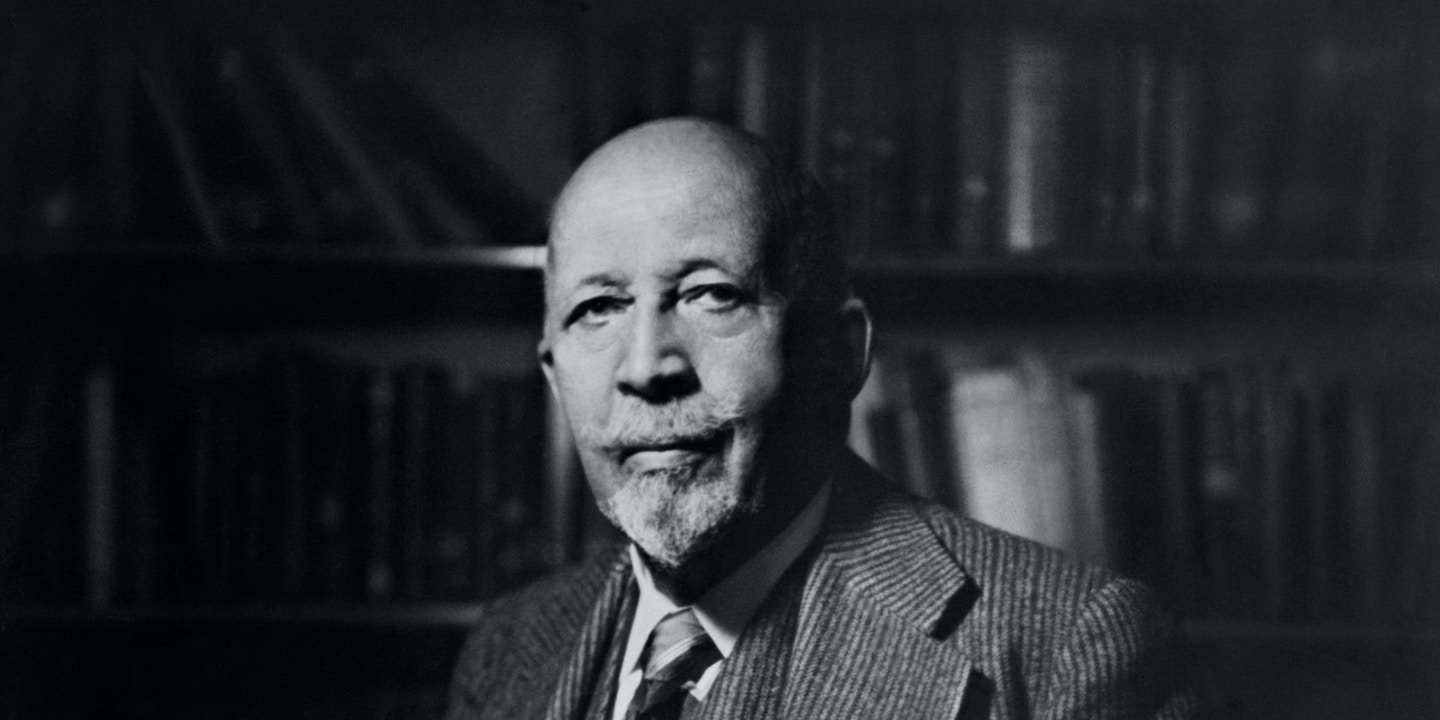www.aljazeerah.info
Opinion Editorials, June 2020
Archives
Mission & Name
Conflict Terminology
Editorials
Gaza Holocaust
Gulf War
Isdood
Islam
News
News Photos
Opinion Editorials
US Foreign Policy (Dr. El-Najjar's Articles)
www.aljazeerah.info
Juneteenth 1865 Was Freedom Won by the Freed, How to Mark it in the Year 2020 By Matthew Cunningham-Cook and Ryan Grim The Intercept, June 20, 2020 |
|
 |
|
|
W. E. B. Du Bois, American sociologist, educator, editor, and writer who helped create the NAACP |
How to Mark Juneteenth in the Year 2020?
TO HONOR JUNETEENTH, Target’s Chair and Chief Executive Brian Cornell released a somber statement. “We recognize the racial trauma the country is experiencing now is not new, but throughout recent weeks there has been a sense that this time is, and has to be, different,” said Cornell, who makes 767 times the average Target worker. “Juneteenth takes an additional significance at this moment.”
On the flip side, the United Auto Workers is shutting down assembly lines for eight minutes and 46 seconds on Juneteenth, marking the time it took Minneapolis police to take George Floyd’s life. The dockworkers on the West Coast, members of the progressive International Longshore and Warehouse Union, or ILWU, are also shutting down ports in honor of Juneteenth. This latter approach is far closer to honoring the true history of Juneteenth.
The holiday marks, generally, the end of slavery in the United States, and more specifically the order of Gen. Gordon Granger that declared the freedom of enslaved people in Texas, a state that was a stubborn holdout after Gen. Robert E. Lee had surrendered his army. The order was read on June 19, 1865, and lore has it that upon learning of emancipation, those it applied to stopped working instantly and launched into celebration.
That wasn’t the only work stoppage that Juneteenth celebrates. Some of the discourse surrounding Juneteenth is palatable to corporate America because it can reinforce some of the comforting ideas about the Civil War: that Abraham Lincoln and the generals of the Union Army, in their benevolence, freed the slaves.
The reality, argued W.E.B Du Bois in a series of landmark works, is that some 500,000 Black Americans freed themselves from slavery by walking off their plantation, with many of them joining up with the Union Army. Then, with the help of some Union Army officers, they organized themselves into soldiers, officers, farmers, spies, cooks, and nurses who enabled the Union to win the war, while their absence on plantations crippled the South’s economy. This is the true Juneteenth: a freedom won by the freed.
The Civil War, and therefore emancipation, was won for the Union in large part thanks to a mass “general strike” of enslaved Black Americans, as revealed by Du Bois in his seminal 1935 work “Black Reconstruction,” which historian Eric Foner has described as “a landmark of historical scholarship and essential reading for anyone seeking to understand the era of Civil War and Reconstruction.” The book, which to this day has never been reviewed in the American Historical Review, the central organ of American historians, ran roughshod over the then-dominant white supremacist school of historiography, known as the Dunning school. The Dunning school saw the democratic explosion wrought by Reconstruction as a great historical crime and the participation of Black Americans in the war and Reconstruction as a sideshow at best.
In taking apart the Dunning school, Du Bois posited that every army depends on its logistics. Soldiers do need food and medical supplies. World War II Admiral Lynde McCormick said that “logistics is all of war making, except shooting the guns, releasing the bombs, and firing the torpedoes.”
Using the same logic, Du Bois noted that “The Southern worker, black and white, held the key to the war; and of the two groups, the black worker raising food and raw materials held an even more strategic place than the white.”
Du Bois had always recognized what Reconstruction had really meant. In the space of just a few years, hundreds of Black Americans denied citizenship were elected to office. Hundreds of thousands more became landowners. The plantation economy was wiped away. In his 1903 work, “The Souls of Black Folk,” Du Bois had expounded on this, challenging the predominant narratives of corruption and revivifying the awesome tasks achieved by the Freedmen’s Bureau. But in the face of the Great Depression he decided a deeper study was needed. The year before Du Bois wrote “Black Reconstruction,” in 1934, hundreds of thousands of workers had gone on strike, and workers in Minneapolis and the San Francisco Bay had general strikes. The change in historical circumstances required a new theoretical analysis.
Lincoln was ever reluctant to make explicit the root cause of the war: slavery; and what it would take to win it: emancipation. But the circumstances demanded that Lincoln do so. John C. Fremont, a radical Republican general, who had been the party’s first nominee four years before Lincoln, had freed slaves under his command in Missouri in 1861, and Lincoln had “repudiated” him, Du Bois noted.
Black Americans forced Lincoln’s hand. Du Bois quoted John Eaton, a colonel in the Union Army who was appointed superintendent of freedmen, as writing “Imagine, if you will … an army of slaves and fugitives, pushing its way irresistibly toward an army of fighting men, perpetually on the defensive and perpetually ready to attack. … There was no plan in this exodus, no Moses to lead it. Unlettered reason or the mere inarticulate decision of instinct brought them to us. Often the slaves met prejudices against their color more bitter than any they had left behind. But their own interests were identical, they felt, with the objects of our armies; a blind terror stung them, an equally blind hope allured them, and to us they come.”
Early on Southern newspapers had boasted of their ability to draft a far larger proportion of military-aged white men than the North, as they could do so without disrupting industrial production. Despite the numerous rebellions and the searing example of Haiti 60 years earlier, the South thought that the defeat of John Brown’s forces at Harper’s Ferry in 1859 portended a population immune to revolt.
The Confederacy was completely unprepared for this general strike. “Hundreds of thousands of slaves were very evidently leaving their masters’ homes and plantations,” wrote Du Bois. And with draft riots creating huge political problems for Lincoln, the initial approach, which was keeping Black Americans relegated to spying, cooking, nursing, and farming for the Union, would no longer work.
“The men who handled a spade for the Northern armies, the men who fed them, and as spies brought in information, could also handle a gun and shoot,” wrote Du Bois. “Without legal authority and in spite of it, suddenly the Negro became a soldier. Later his services as soldier were not only permitted but were demanded to replace the tired and rebellious white men of the North. But as a soldier, the Negro must be free.”
The general strike, Du Bois wrote, “was not merely the desire to stop work. It was a strike on a wide basis against the conditions of work. It was a general strike that involved directly in the end perhaps a half million people. They wanted to stop the economy of the plantation system, and to do that they left the plantations.” Of those 500,000, 130,000 to 200,000 ended up joining the Union Army in various capacities.
The mass of refugees were organized by Eaton with a corps of Black officers, the great forces of production created profits and tax revenue for the Union Army, which began the Reconstruction of the South. General wage taxes were put on the Black Americans serving the Union Army, and those taxes went to fund the construction of schools, hospitals, and infrastructure to serve the community.
The general strike of Black Americans in the South created an exodus of poor whites as well. As the Union Army marched on and the strike crushed the ability of the Confederacy to respond. “If the Negro was to be free where would the poor white be? Why should he fight against the blacks and his victorious friends? The poor white not only began to desert and run away; but thousands followed the Negro into the Northern camps,” Du Bois wrote.
The Emancipation Proclamation was issued effective January 1, 1863. It was a turning point in the war. “The Proclamation made four and a half million laborers willing almost in mass to sacrifice their last drop of blood for their new-found country. It sent them into transports of joy and sacrifice. It changed all their pessimism and despair into boundless faith. It was the Coming of the Lord.” Du Bois concluded, “it was thus the black worker, as founding stone of a new economic system in the nineteenth century and for the modern world, who brought civil war in America. He was its underlying cause, in spite of every effort to base the strife upon the union,” rejecting the then-dominant “War of Northern Aggression” narrative.
Indeed, just as Black Americans denying their labor to the South and offering their service instead to the Union turned the tide of the war, wildcat resistance to enslavement is what brought the nation to that war.
From our vantage point today, it’s difficult to understand just how deeply preoccupied the slaveholding class was with people who escaped slavery. But it’s also hard to overstate. Entire industries existed to prevent escape and to capture and return those who made it. Abolitionists made supporting fugitives central to their campaign against slavery, with the Underground Railroad the most vivid expression of the effort.
Quakers and other whites who resisted slavery created sanctuary communities, passing laws that barred state and local authorities from assisting slave catchers. Southern slavers launched raids into the North in search of escapees, often repelled in high-profile and violent fashion. The escapees who told their stories publicly up North, Frederick Douglass most famously among them, had a dramatic effect on public opinion, exploding the propaganda that slavery was ultimately a benign institution. After the smash commercial success of “Uncle Tom’s Cabin,” Southern propagandists argued that the fiction was just that, fiction produced by a biased white abolitionist, Harriet Beecher Stowe, with no grounding in the reality of the institution.
A year later, a previously free Black man, Solomon Northup, re-won his freedom after 12 years in captivity, following his horrifying abduction in New York. Northup’s own memoir, titled “12 Years a Slave,” was an explosive, culture-defining best-seller in 1859, telling the story of his abduction from New York and time spent in brutal captivity. The two works acted as a call-and-response, with Northup dedicating his book to Beecher Stowe.
Aware of the profound weakness at the heart of the slave system — the relentless resistance of the people it chained — the slave states had turned to Congress, and made the issue of fugitives a defining political priority. This culminated in the Fugitive Slave Act of 1850, which passed as the central component of the Compromise of 1850. It passed only narrowly, and if the Southern states didn’t have extra members of Congress as a result of the three-fifths compromise — whereby slave states were awarded additional congressional representatives based on the number of slaves living there, but only counted as three-fifths of a person — the bill would have fallen short.
The new law required officials to arrest any black-presenting person that a Southerner swore was an escaped slave. It implemented stiff penalties for harboring fugitives and gave those arrested no opportunity to plead their case. Not only were escaped slaves captured and brought back, free Blacks like Northup were, too. As the risk of slaves escaping decreased, their price rose significantly in the border states. Now that any Black person was at risk of being sent into slavery, the Black population of Canada exploded.
The Fugitive Slave Act forced whites in the North to reckon with slavery, to choose sides. The Whig Party, which had long been a coalition that straddled North and South and simply preferred to ignore the issue of slavery, relied for its existence on a pro-slavery party — the Democrats — that was, for lack of a better word, moderate — one that was content to keep slavery in the South, and agree to “reasonable” restrictions on the trade. The Fugitive Slave Act broke apart that arrangement, making it clear that the extremists in the slavocracy were in charge in the South, and they wouldn’t stop until they had achieved a hemisphere-wide slave empire. Moderation and compromise could no longer counter the far right. Only a movement bent on the full blown destruction of slavery was capable of meeting the challenge. It was the 19th Century American version of socialism or barbarism, and the Whigs were not up to it.
The Whig Party collapsed amid its implacable internal contradiction. In its place rose the Republican Party, founded on principles of abolition. The South had swung the nation in such an extreme direction that it radicalized the rest of the country in the opposite. Had it not been for those unfathomably brave people willing to risk everything to escape slavery, there would have been no realignment, and no Civil War — at least not the one we had, when we had it.
As Reverend Dr. William Barber argues that our present moment is a Third Reconstruction, it is also important to remember that the Second Reconstruction–the civil rights movement–too was built on a foundation of workers. Along with Freedom Rides, sit-ins and student movements, millions of Black workers organized to join unions in the ‘60s and ‘70s, much of them in the public sector. Martin Luther King came to the aid of Memphis sanitation workers because he saw the potential for a new movement, one based on workers taking action for themselves. It was also in 1968 that King gave a speech praising Du Bois’ “Black Reconstruction,” historian Robert Greene II points out.
Labor journalist Mike Elk has been tracking strike actions since the beginning of the COVID-19 pandemic. Since the murder of George Floyd, there has been a verifiable surge of strike activity. There may be no better way to mark Juneteenth in the year 2020.
Some language from this article is excerpted from the book “We’ve Got People.”
https://theintercept.com/2020/06/19/how-to-mark-juneteenth-in-the-year-2020/
***
Share the link of this article with your facebook friends
|
|
|
|
||
|
||||||




